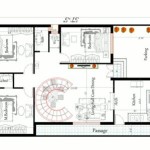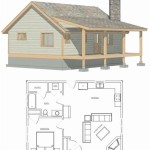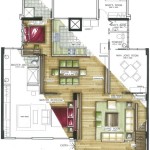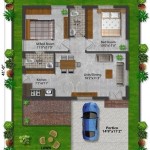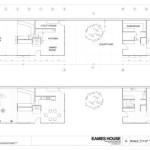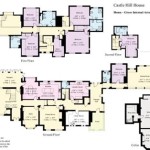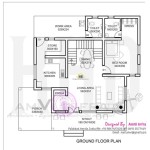Small House Engineering Plans: A Comprehensive Guide
Small house living has gained significant popularity in recent years, driven by factors such as affordability, environmental consciousness, and a desire for simpler lifestyles. A crucial aspect of building a small house is the development of comprehensive engineering plans. These plans provide a detailed roadmap for construction, ensuring structural integrity, safety, and compliance with building codes.
Engineering plans typically encompass various disciplines, including structural, mechanical, electrical, and plumbing. Structural plans address the load-bearing elements of the house, ensuring stability and resistance to forces like wind, snow, and earthquakes. These plans detail the foundation, framing, roofing, and other structural components, specifying materials, dimensions, and connections.
Mechanical plans focus on the heating, ventilation, and air conditioning (HVAC) systems. They outline the placement of ductwork, vents, and equipment, ensuring proper airflow and temperature control. These plans may also include specifications for energy-efficient systems like heat pumps or solar panels, contributing to the sustainability of the small house.
Electrical plans detail the wiring, lighting, and power distribution throughout the house. They specify the location of outlets, switches, fixtures, and appliances, ensuring safe and efficient electrical service. These plans also address grounding and other safety measures to prevent electrical hazards.
Plumbing plans illustrate the layout of water supply and drainage systems. They detail the location of pipes, fixtures, and appliances, ensuring proper water distribution and wastewater removal. These plans may also include specifications for water-saving fixtures and greywater recycling systems, further enhancing the sustainability of the small home.
The development of engineering plans for a small house requires careful consideration of several factors. The size and shape of the house influence the structural design and the layout of mechanical, electrical, and plumbing systems. The climate also plays a significant role, dictating the insulation requirements and the capacity of the HVAC system.
Local building codes and regulations must be adhered to throughout the planning and construction process. These codes specify requirements for structural integrity, fire safety, accessibility, and energy efficiency. Compliance with these codes is essential for obtaining building permits and ensuring the safety and legality of the small house.
Working with qualified professionals is crucial for developing comprehensive and accurate engineering plans. Structural engineers can analyze the structural integrity of the design, ensuring it can withstand the anticipated loads. Mechanical, electrical, and plumbing engineers can design efficient and safe systems that meet the needs of the occupants.
The cost of developing engineering plans varies depending on the complexity of the design and the location of the project. However, investing in professional engineering services is essential for ensuring the safety, durability, and functionality of the small house.
Software tools are increasingly used in the development of engineering plans. Computer-aided design (CAD) software allows engineers to create detailed 3D models of the house, facilitating visualization and analysis. These tools can also automate calculations and generate construction documents, improving efficiency and accuracy.
Sustainable design principles can be integrated into the engineering plans. This may involve incorporating energy-efficient appliances, using sustainable building materials, and designing for passive solar heating and cooling. These strategies can reduce the environmental impact of the small house and lower operating costs.
Prefabrication and modular construction methods can be facilitated by detailed engineering plans. These methods involve constructing sections of the house off-site in a controlled environment, then transporting and assembling them on the building site. This can significantly reduce construction time and costs.
Adaptability and flexibility should be considered during the planning process. The needs of the occupants may change over time, so designing for future modifications can be beneficial. This may involve incorporating flexible spaces that can be repurposed or designing for easy expansion.
Proper documentation is essential throughout the engineering process. Maintaining detailed records of calculations, specifications, and approvals can facilitate communication among stakeholders and ensure compliance with regulations. This documentation can also be valuable for future maintenance and renovations.
Regular inspections during construction are crucial for verifying that the work is being carried out according to the engineering plans. These inspections can identify potential issues early on, preventing costly rework and ensuring the quality of the construction.
Engineering plans serve as a vital blueprint for building a successful small house. They provide a detailed roadmap for construction, ensuring structural integrity, safety, and compliance with building codes. By working with qualified professionals and incorporating sustainable design principles, individuals can create small homes that are both functional and environmentally responsible.

40 Most Beautiful House Plan Ideas Engineering Discoveries Little Plans 30x40

Small House Plan Ideas For Diffe Area Engineering Discoveries Design Plans Home

30 Small House Plan Ideas Engineering Discoveries Design Plans Little

Top 50 Amazing House Plan Ideas Engineering Discoveries Simple Plans Model 40x60

House Plans Home Residential

30 Amazing Diffe Types Of House Plan Design Ideas Engineering Discoveries Create Plans Home

Standard House Plan Collection Engineering Discoveries Plans Simple Bungalow Floor

30 Small House Plan Ideas Engineering Discoveries

Small House With Excellent Planning Of The Area For A Family Four Engineering Feed Bungalow Plans Model Plan

Small House Plan Ch10


